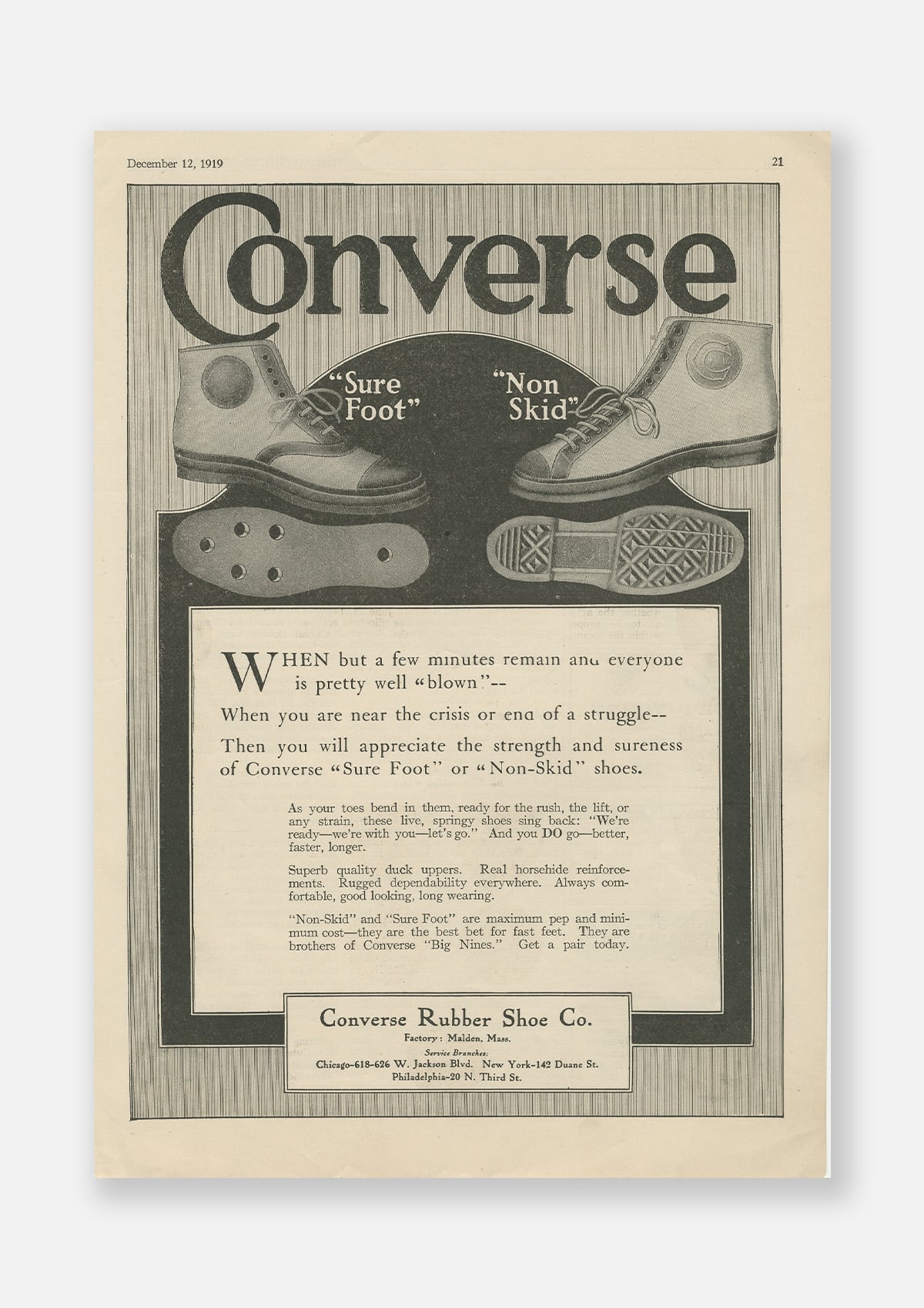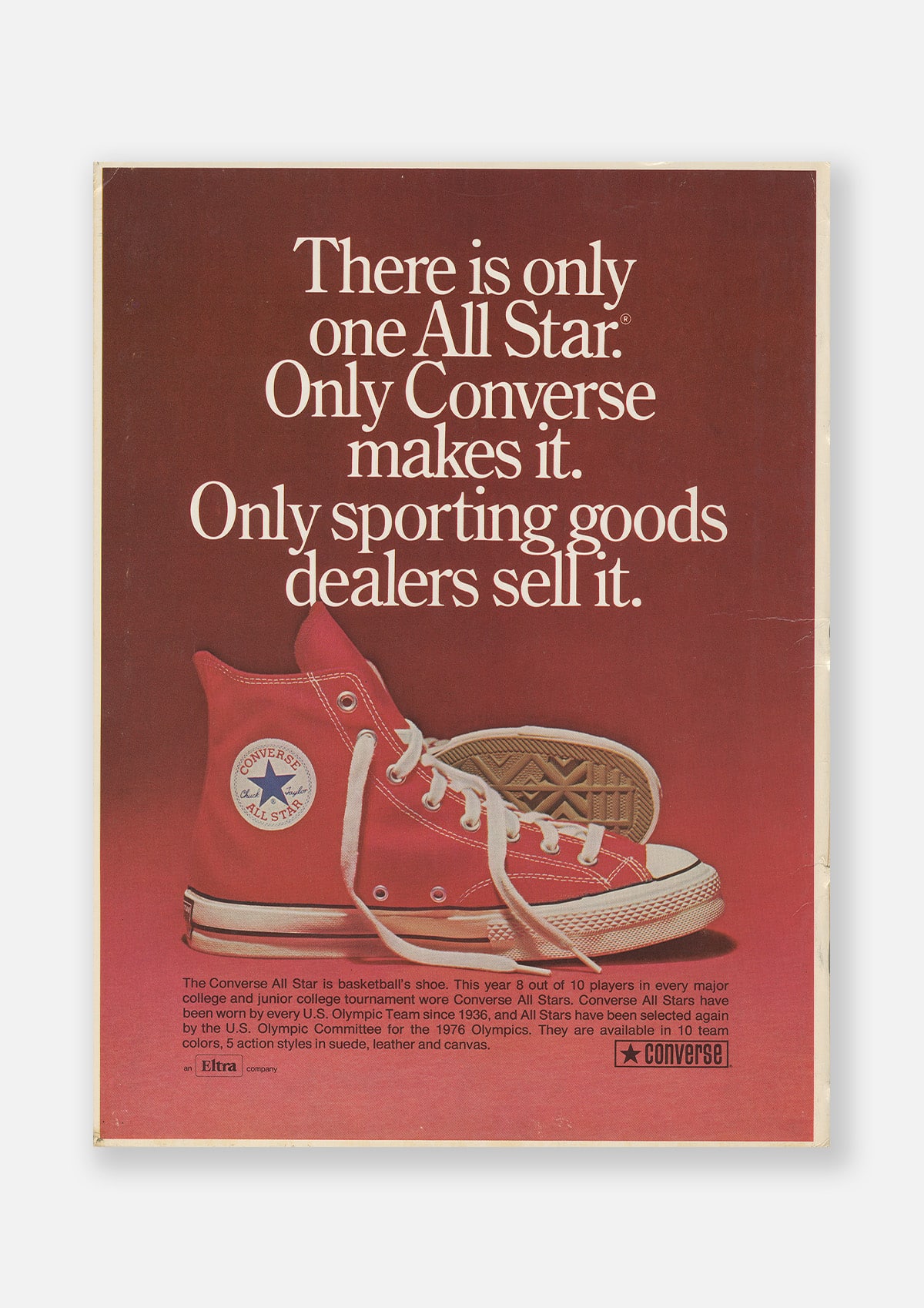“I swear you have a different pair of Converse for every day of the week,” my colleague Elliott declares, his eyes darting down towards a pair of sand-coloured All Stars that I have expertly (if I do say so myself) paired with an old pair of army chinos. I shrug and smile back, requisite in the knowledge that at this very moment, I have a pair of all-white CX Chuck Taylors in my bag that I’ll take to the gym later, a pair of charcoal All Stars under my desk for meetings and a beat-up pair that I will wear while gardening this weekend. “Yep, something like that.”
I make no apologies for my slightly one-eyed patronage. The indelible mark that the iconic high-top canvas sneaker has left on my personal style cannot be understated. And I’m not alone. For close to a century, ‘Chucks’ have served as a symbol of rebellion, individuality and style, weaving a rich tapestry of self-identity with each and every step. It is, to put it lightly, one of fashion’s great contradictions.
Despite adorning the ankles of millions and lending his name to arguably the world’s most popular sneaker, Chuck Taylor—the man, remains an enigma, even to me.

Who Was Chuck Taylor?
A figurehead who has seemingly lived a thousand lives, Chuck Taylor has become a legend of fashion folklore. In some stories, the Indiana native is portrayed as a burgeoning basketball coach with a penchant for arch-support. In others, a travelling salesman committed to breaking new commercial ground. The truth, according to Converse, lies somewhere in the middle.
“In 1922, Converse hired Chuck Taylor as a salesman and coach/player for Converse’s promotional basketball team, the All Stars,” a spokesperson for the iconic brand tells me. “Converse wanted to leverage the All Stars team to promote the brand, as well as grow the popularity of basketball. In addition to playing in exhibition games, Chuck Taylor hosted clinics around the country where he taught coaches and players winning plays and strategies.”
The enterprising up-starter saw the All Star game as an opportunity to create a network of Converse-affiliated coaches and in just a few short years, had established himself as a coaches’ coach.
“Since basketball shoes were marketed to coaches at the time, Chuck’s work allowed Converse to grow just as basketball was gaining popularity around the country. By 1933, Chuck’s decade-long work made him the top basketball coach of that time. In 1934, Converse named their signature shoe the Chuck Taylor All Star, validating and cementing the association between Converse, Chuck Taylor and basketball.”
In many ways, Taylor was among the first true celebrity ambassadors. Active well before the NBA, when players still had day jobs, the basketball tragic understood the importance of catering to players’ needs and coaches’ requests, but contrary to popular belief, Taylor’s influence never crossed the design studio threshold.

“In the end, he did become this larger-than-life figure because he was such an expert on all things basketball, including knowing the best shoes for the game. He did all this without ever really impacting the design of the shoe.”
Origins of an All Star
Founded in 1908 by Marquis Mills Converse in Malden, Massachusetts, the Converse Rubber Company’s story is one of constant refinement. In the early days, manufacturing largely focused on winter-heavy products, namely galoshes and boots, with the warmer weather representing a gaping hole in the product catalogue. To combat this, Converse created a line of tennis shoes in 1910, which later expanded in 1916 to include other sports like golf and basketball.
This decision was further compounded when Converse opted to move its headquarters to Springfield, Massachusetts, the birthplace of modern basketball and the home of the sport’s creator James Naismith. With that relocation, Converse had a front-row seat to the emerging sport, leading to the advent of the original All Star, then known as the Non-Skid.
“When the All Star was released in 1917, basketball shoes were simple,” the spokesperson tells me. “The ConverseLite Six featured a “suction sole” design that consisted of six holes punched into a smooth, flat outsole, which was intended to give the wearer traction. If you compare the “suction sole” to the tread pattern of the All Star, it is night and day in terms of engineering and functionality.”
The original release’s unique diamond-shaped tread was among the most significant developments. With this addition, players were able to push off in multiple directions without skidding around the court, hence the name. The brand would then go on to add features like ventilation eyelets and a pivot button to the front of the tread to help the sneaker last longer. Innovation would continue to play a significant role in the All Star’s growth over the next two decades, however, it would take until the 1950s for Converse’s premier release to break into the mainstream.



Shift in Culture
In 1957, America was still reeling from the death of James Dean and the rise of counterculture was gathering steam. Teenagers were becoming disillusioned with the rigid formalities of the nuclear structure and the country was perched on the precipice of a great cultural change. Enter the Converse All Star low-top, the sneaker that defined a generation of outcasts.
An oral history of the Converse All Star, taken in the early 1990s, reveals the sentiment surrounding counterculture at the time. In the recording, a salesman explains that while the low-top was originally designed for basketball players, it was the people of Southern California who made the sneaker a success.
“He called them “beach boys” and said they wore the sneakers with “cutoff chinos” to the beach because they were easy to kick on and off,” the spokesperson explains of the recording. “This style of Southern California surf culture spread from the West Coast to the East spiking the sales of black low-tops for casual wear.”
This reinvention of the purpose-designed sports shoe set Converse on an entirely new path. For the first time, the Massachusetts-born company was at the vanguard of the fringe movement and it was here the All Star made its name.
“One of the offshoots of this early surf culture was skateboarding, and Converse was right at the birth of that new culture,” the Converse historian explains. “Then there was the idea of the intersectionality of sports, fashion, music, and culture. Surf culture would morph into counterculture, then into punk-rock, hip-hop and grunge — Converse was at the heart of all these moments.”

Evolution of the Underground
It’s true, a look back at the 20th century’s most defining pop-culture moments will undoubtedly speak to the popularity of Converse. Through the ‘70s, the sneakers were the uniform of the New York punk scene, while in the ‘80s, they became the footwear of choice for anti-establishment rap groups like N.W.A. Even 2Pac famously rapped ‘In L.A. we wearin’ Chucks, not Ballys’ in his 1995 hit ‘California Love’.
Such is the impact that Converse has had on the underground movement that the sneaker has managed to traverse cultural divides. It doesn’t matter if you are a punk, surfer, skater or hip-hop fan, the All Star has a place in your world.
“Converse has been adopted around the world and across cultures by musicians, artists, athletes, dreamers, and thinkers for over a century. It is one of those rare pieces of clothing or footwear that can mean so many different things based on the person who wears it.”
“If you see someone wearing a pair of Chucks, you can tell something about them and how they feel about the world and culture.
“The Chuck is worn by so many different artists, but for each one it represents a different aspect of their self-expression.”
In the 1980s, Converse experimented with different patterns and textures, taking individuality to the extreme. The brand introduced camouflage prints in 1983 and animal prints in 1987, before changing the silhouette with platform versions and a variety of colour variations in the 1990s.
In recent years, the All Star has taken a more modern approach, with 2015 marking the introduction of the CX line. With this range, the brand tinkers and toys with new materials, working to improve sustainability and comfort, however, it hasn’t forgotten where it came from.

The introduction of the Chuck 70 in 2013 is perhaps the most fitting addition to the All Star lineup. A release that pays homage to the influence of Chuck Taylor, a man who has meant so many different things to so many different people, the sneaker is a remake of the All Star as it was in 1970 at the tail end of its dominance on the basketball court. A constant reminder of its illustrious, if not humble, origins, the latest All Star is the foundation for a new era of counterculture.
“The Chuck Taylor All Star will continue to be an icon,” the Converes spokesperson tells me. “The heritage of the silhouette is constantly a catalyst for creativity, and we’ll continue to iterate and experiment with the DNA of the Chuck and collaborate with those challenging convention to provide a range of styles that provoke and inspire.”
In many ways, the Chuck Taylor All Star is pop culture’s great unifier. Designed for athletes, adopted by outcasts, and embraced by the underground, the sneaker (much like the enigmatic character behind it) has lived a thousand lives. In reality, Chuck Taylor may not have been the man responsible for bringing the All Star to life, but he was certainly the person tasked with bringing it to the masses.






































Comments
We love hearing from you. or to leave a comment.